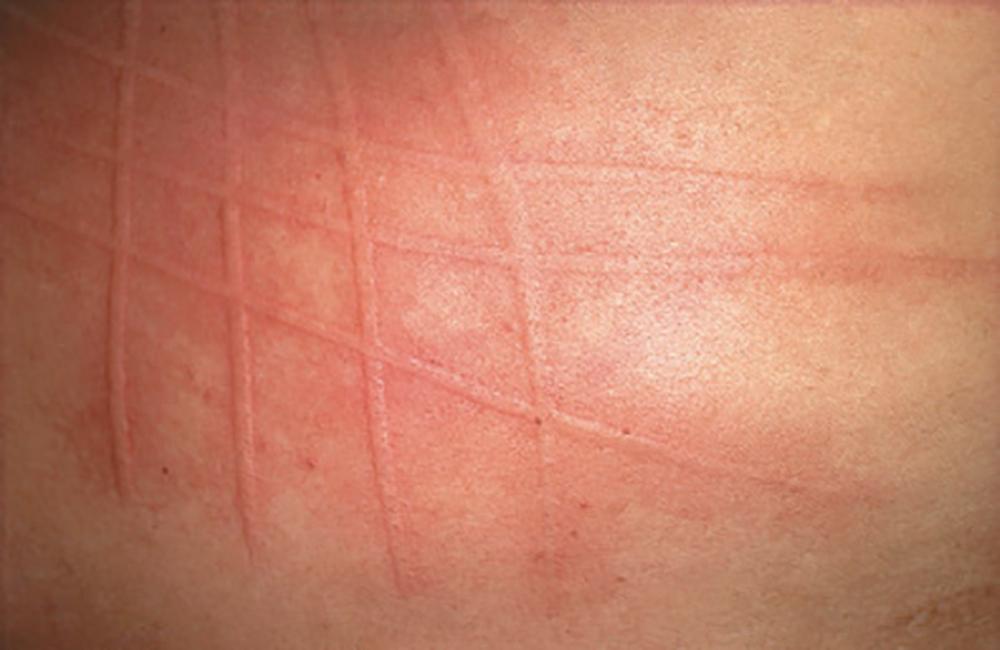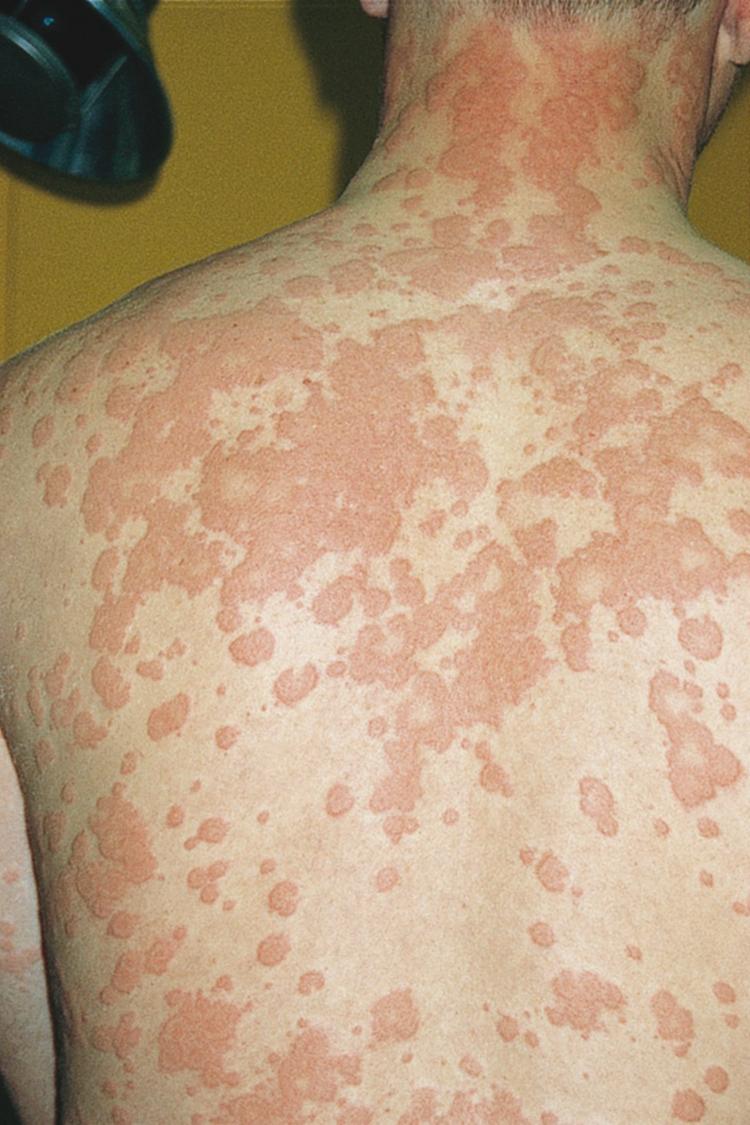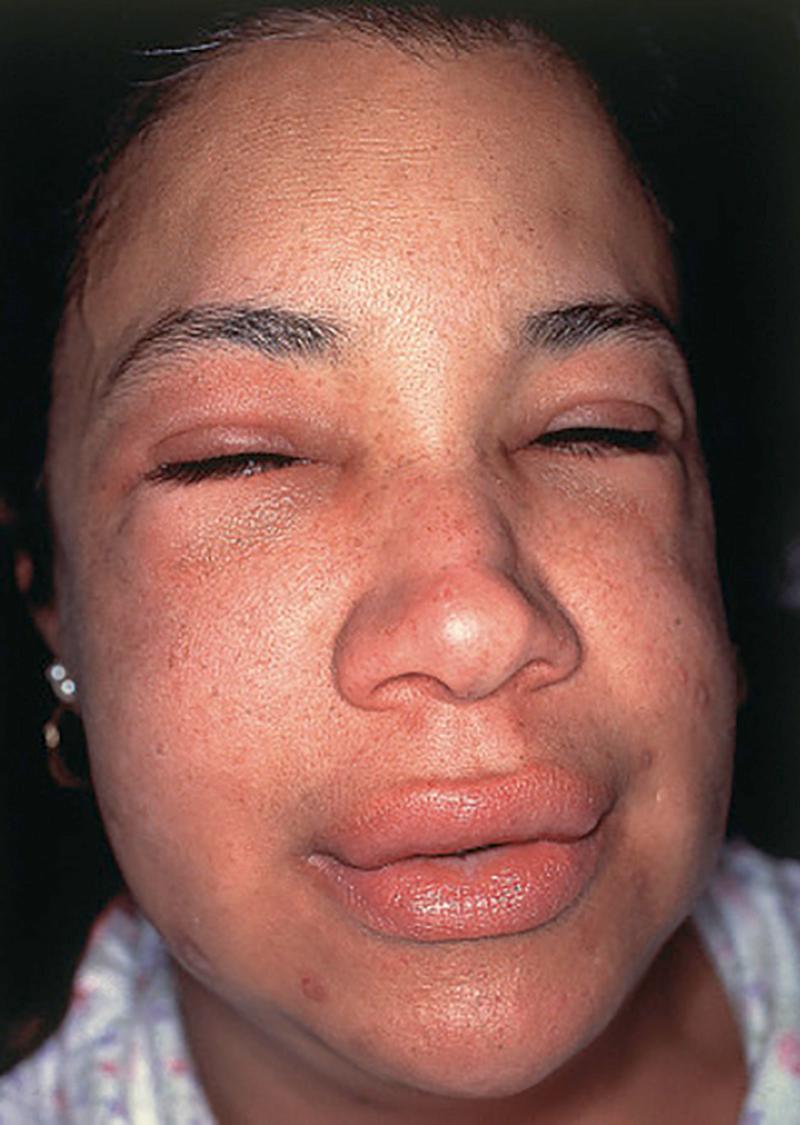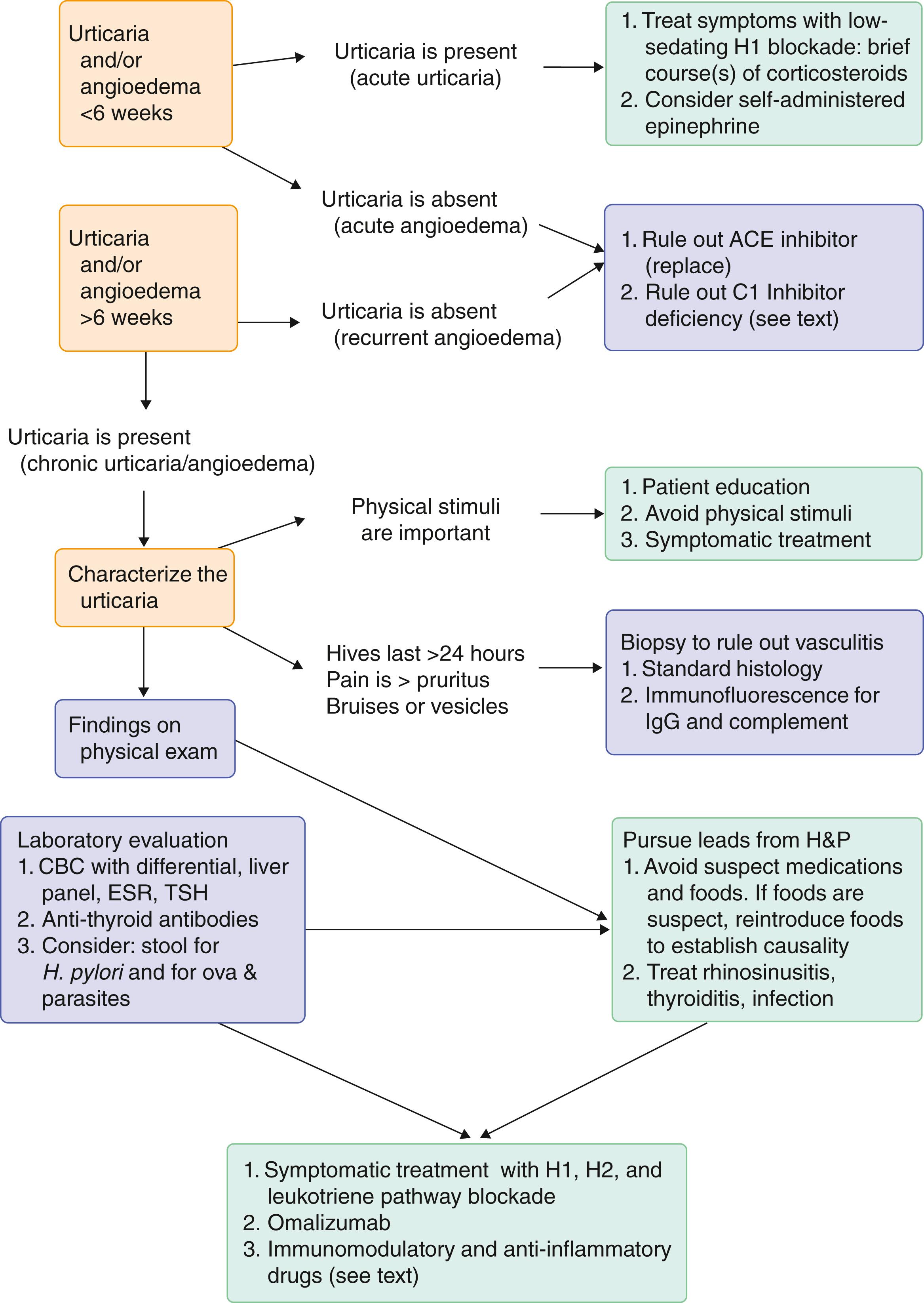Physical Address
304 North Cardinal St.
Dorchester Center, MA 02124
Acute and chronic urticaria, which involve the dermis, are caused by the excessive release of histamine from mast cells—sometimes acute and sometimes chronic, and sometimes with and sometimes without a trigger. Angioedema, which also involves subcutaneous tissue, can accompany histamine-driven urticaria or can be caused by excessive bradykinin, either as a result of hereditary angioedema or specific provoking agents.
Episodes of urticaria or angioedema are classified by their duration and by the presence of a known trigger. Acute urticaria persists for less than 6 weeks, whereas chronic urticaria is defined by recurrent urticaria, angioedema, or both for more than 6 weeks. Chronic urticaria is further divided into the 20% or so of patients who have a specific physical stimulus or trigger (e.g., heat, cold temperature, elevation in body temperature, vibration, or sunlight) for their hives (chronic inducible urticaria) as compared with the 80% or so who experience skin lesions of chronic spontaneous urticaria without a clear trigger. The most common presentation of chronic spontaneous urticaria is urticaria alone (50%), followed by both urticaria and angioedema (40%) and recurrent angioedema only (10%). The term chronic spontaneous urticaria encompasses clinical phenotypes that include both urticaria and angioedema.
About 25% of both females and males will have an episode of acute urticaria in their lifetime. For chronic urticaria, the estimated prevalence is 0.1 to 1%, with an average onset in third to fifth decade of life, and adult females are more often affected than males (2:1). In the majority of patients, the duration of chronic urticaria is self-limited and ranges from 2 to 5 years. In individuals with chronic inducible urticarias, however, the duration can be much longer.
A central feature of skin lesions of urticaria is the activation of mast cells, which are found throughout the skin of the body in varying numbers. Within minutes, activated mast cells can release mediators such as stored histamine, leukotriene C4, and prostaglandin D2, thereby leading to vasodilation, leakage of plasma into the dermis, and creation of the sensation of pruritus via activation of sensory nerves. A few hours later, mast cells release cytokines that can lead to the recruitment of lymphocytes, eosinophils, and basophils into the skin tissue. Angioedema, which results from a similar extravasation of fluid in deeper dermal and subcutaneous tissues, takes 24 to 72 hours to resolve.
In acute urticaria, the activating triggers for mast cells include immediate hypersensitivity reactions to drugs or foods, as well as to the inflammatory process of a viral illness. However, no clear trigger is found in over 50% of cases. Among the implicated foods in children are milk, egg, and peanuts, whereas peanuts, tree nuts, fish, and shellfish predominate in adults. These food allergens and some drugs (e.g., penicillins) crosslink specific IgE that is bound to the surface of mast cells via high-affinity receptors (FcεRI) and activate the release of mediators. Commonly implicated drugs are antibiotics (penicillins, sulfonamides), nonsteroidal anti-inflammatory drugs, and muscle relaxants. Mast cells can be activated by non–IgE-based pathways via a receptor called MRGPRX2. Drugs that can activate this receptor include opioids, muscle relaxants, and antibiotics such as ciprofloxacin. Hives also can be precipitated by scombroid food poisoning ( Chapter 98 ), in which fish that are contaminated with bacteria produce histamine, which then leads to hives.
In chronic spontaneous urticaria, the mechanisms by which mast cells are activated are less clear. Serum autoantibodies are detected in up to 40% of cases, thereby suggesting an autoimmune mechanism. Such autoantibodies include IgG that targets either the high-affinity IgE receptor (FcεRI) or IgE and thereby activates skin mast cells. Some patients with chronic spontaneous urticaria express thyroid IgG autoantibodies.
In chronic inducible urticaria, the trigger for the activation of mast cells is more specific. In the case of dermographism (writing on the skin), mild pressure or stroking of the skin will activate the local tissue mast cells ( Fig. 232-1 ). This type of chronic inducible urticaria is often also seen in patients with chronic spontaneous urticaria. In cholinergic urticaria, patients experience short-lived hives when their body temperature is elevated, such as with exercise. Cold-induced urticaria activates mast cells beneath a well-defined temperature threshold.

In rare cases of chronic urticaria and angioedema, a food or drug allergen is identified. In addition, contact allergens such as soaps, detergents, cosmetics, or latex may be involved. Urticaria may also occur secondary to an unrecognized autoimmune condition such as rheumatoid arthritis ( Chapter 243 ), systemic lupus erythematosus ( Chapter 245 ), a systemic vasculitis ( Chapter 249 ), or thyroid disease ( Chapter 207 ) or, extremely rarely, as a paraneoplastic skin phenomenon ( Chapter 164 ). In endemic areas, parasitic infections with strongyloides ( Chapter 327 ) or filariasis ( Chapter 327 ) can be associated with urticaria.
Urticaria (hives) is a pruritic, erythematous, papular skin lesion that can be raised, can have a pale center, and can extend from several millimeters to centimeters in size ( Fig. 232-2 ). Each individual lesion may persist for up to 24 hours. Lesions of longer duration should raise concern for other diagnoses ( Chapter 407 ). Angioedema is defined by the rapid onset of nonpitting edema in the subdermal or mucosal tissues without erythema or well-defined borders. Areas of angioedema can be associated with a sensation of tingling, pressure, pain, or burning. Commonly involved areas include the face, cheek, lips, tongue, hands, feet, and genitalia ( Fig. 232-3 ). Angioedema typically does not resolve as rapidly as urticaria and can persist for up to 72 hours.


Pruritus commonly precedes and then accompanies the eruption of papular hives or wheals. Hives or wheals may be round, annular, or serpiginous; they can appear in groups, can coalesce, and also appear several times a day. The typical time course of individual hives can be 30 minutes to 24 hours before full resolution of the skin without ecchymoses.
Chronic spontaneous urticaria frequently involves areas of constant pressure (e.g., the waistband), thereby supporting overlap of chronic spontaneous urticaria with chronic inducible urticarias such as dermographism. If a patient is taking antihistamines, the lesions appear flattened. The severity of pruritus can disrupt both daytime activities and sleep. In more severe cases of chronic urticaria, extracutaneous symptoms can include headache, fatigue, wheezing, gastrointestinal complaints, or a joint pain.
Some chronic inducible urticarias present with unique clinical features. In cold-induced urticaria, local lesions appear when the skin is exposed to a sudden drop in air temperature or cold water. In cholinergic urticaria, the wheals appear during physical exertion and resemble smaller papules with large surrounding erythematous bases. With delayed pressure urticaria, the onset of urticaria or angioedema (e.g., hand swelling hours after carrying groceries) occurs 4 hours or longer after the pressure triggers.
Urticaria is usually a clinical diagnosis based on seeing the skin lesions either in person or by a photograph ( Fig. 232-4 ). By definition, urticaria is first subdivided into acute (<6 weeks duration) and chronic forms.

The diagnosis of acute urticaria or angioedema requires a comprehensive history and physical examination with attention to ingestions, the pattern of the eruptions, contactants, recent infections, and review of photographs of past lesions. A history of recent infections or vaccinations and any new exposures to foods and to prescribed or over-the-counter drugs should be elicited, and any close temporal relationship to potential precipitants should be explored. To prove a link to urticaria, the suspected drug or food must be withdrawn; if the reaction is mild enough to be well-tolerated, re-challenge can then confirm the cause. In the majority of cases, however, no trigger is identified.
Become a Clinical Tree membership for Full access and enjoy Unlimited articles
If you are a member. Log in here